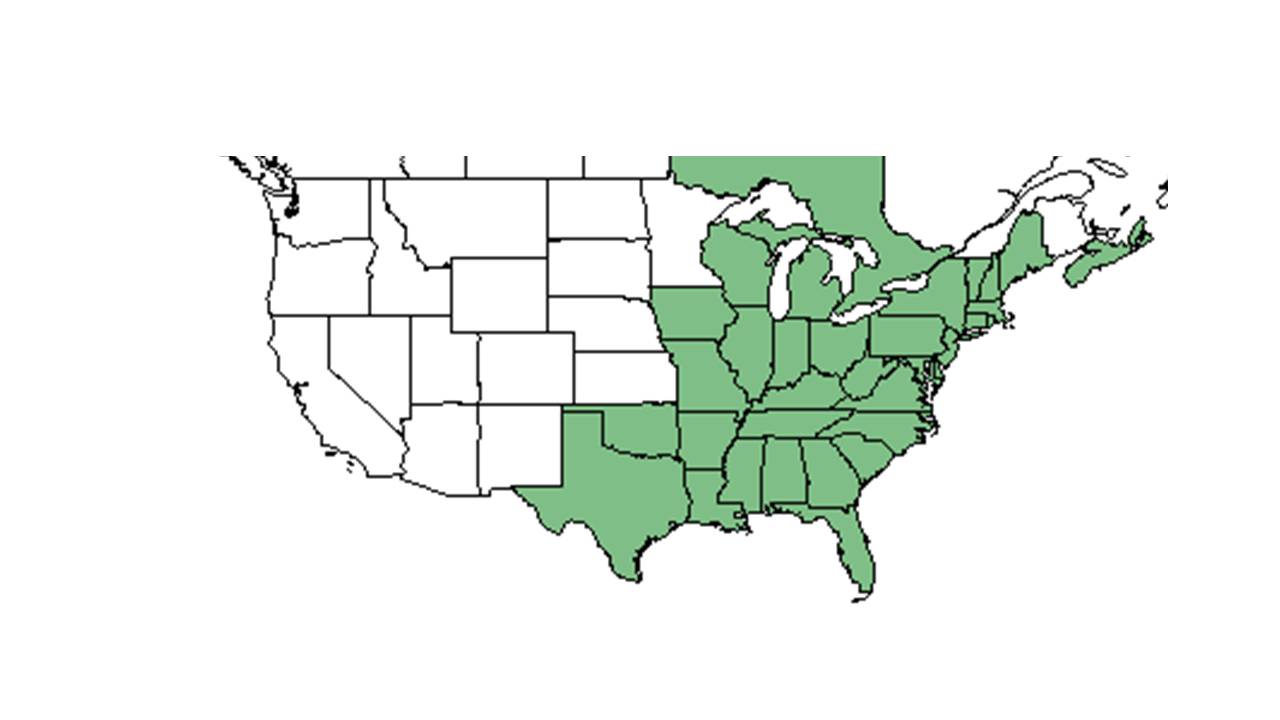Rhexia virginica
| Rhexia virginica | |
|---|---|

| |
| Photo was taken by Gil Nelson | |
| Scientific classification | |
| Kingdom: | Plantae |
| Division: | Magnoliophyta – Flowering plants |
| Class: | Magnoliopsida – Dicotyledons |
| Order: | Myrtales |
| Family: | Melastomataceae |
| Genus: | Rhexia |
| Species: | R. virginica |
| Binomial name | |
| Rhexia virginica L. | |

| |
| Natural range of Rhexia virginica from USDA NRCS Plants Database. | |
Common names: Handsome Harry[1], Virginia meadow-beauty
Contents
Taxonomic notes
Synonyms: Rhexia stricta Pursh
Varieties: R. virginica var. purshii (Sprengel) C.W. James; R. virginica var. septemnervia (Walter) Pursh
Description
Rhexia virginica is a perennial herbaceous species.
"Erect, herbaceous, hermaphroditic, cymose perennials. Leaves opposite, sessile or petioles to 2 mm long. Flowers 4-merous, floral parts perigynous; stamens 8, anthers 1-locular, poricidal, usually with a basal spur. Capsules globose or subglobose; hypanthium cylindrical in anthesis, urceolate at maturity; stipes or pedicels 2-4.5 mm long; seeds brownish or yellowish, crescent-shape, papillose lined, 0.5-1 mm long except for R. petiolate and R. alifanus."[2]
"Hirsute, usually branched perennial; roots usually tuberous; stems to 9 dm tall, faces equal, winged. Leaves elliptic or ovate, to 7 cm long and 2.6 cm wide, sparsely hirsute, 3-nerved, acute or aristate, ciliate-serrate, base cuneate. Sepals deltoid, 1.5-3 mm long, aristate; petals rose-purple, glandular hirsute marginally beneath, 10-25 mm long, usually mm long, usually glandular hirsute, neck shorter than body."[2]
Distribution
R. virginica is a rare species found in depressional wetlands occurring in Alabama, Georgia, North Carolina, South Carolina, and Virginia.[3]
Ecology
Habitat
Rhexia virginica is found in wet ditches, savannas, flatwoods, and pond margins, and sometimes in standing water.[1] It also has been found in cypress-gum swamps, seepage bogs, lake shores, and other poorly drained situations.[4] It can also occur in some human disturbed areas, especially those with wet conditions, including ditches, roadsides, clearings, power line corridors, and drained and bulldozed bogs.[4] This species seems to prefer partial shade and wet sandy or peaty soils.[4]
Associated species include Eriocaulon, Xyris, Cypress, Liquidambar styraciflua, Cyrilla, Rudbeckia mohrii, Pinus palustris, Pinus taeda, Sarracenia minor, Rhexia cubensis, Eragrostis refracta, Juncus abortivus, Juncus megacephalus, Juncus debilis, Lachnanthes caroliniana, Erigeron vernus, Ludwigia linearis, and Hypericum fasciulatum.[4]
Rhexia virginica is an indicator species for the North Florida Wet Flatwoods community type as described in Carr et al. (2010).[5]
Phenology
R. virginica has been observed flowering from June to October with peak inflroescence in August and September while fruiting has been observed from July through October.[4][1][6]
Fire ecology
This species has been found in frequently burned longleaf pineland habitat.[4] Populations of Rhexia virginica have been known to persist through repeated annual burning.[7]
Conservation, cultivation, and restoration
Cultural use
The greens and tubers can be used in salads for a sweetish, nutty taste.[8]
Photo Gallery
References and notes
- ↑ 1.0 1.1 1.2 Nelson, Gil. Atlantic Coastal Plain Wildflowers: A Field Guide to the Wildflowers of the Coastal Regions of Virginia, North Carolina, South Carolina, Georgia, and Northeastern Florida. Guilford, CT: FalconGuide, 2006. 95. Print.
- ↑ 2.0 2.1 Radford, Albert E., Harry E. Ahles, and C. Ritchie Bell. Manual of the Vascular Flora of the Carolinas. 1964, 1968. The University of North Carolina Press. 743. Print.
- ↑ Edwards, A. L. and A. S. Weakley 2001. Population biology and management of rare plants in depression wetlands of the southeastern coastal plain, USA. Natural Areas Journal 21: 12-35.
- ↑ 4.0 4.1 4.2 4.3 4.4 4.5 Florida State University Robert K. Godfrey Herbarium database. URL: http://herbarium.bio.fsu.edu. Last accessed: June 2014. Collectors: Robert Kral, Loran C. Anderson, Robert K. Godfrey, N. C. Henderson, P. L. Redfearn, N. C. Henderson, Bruce Hansen, JoAnn Hansen, S. C. Hood, John Morrill, Grady W. Reinert, C. E. Wood, W. M. B., Cecil R Slaughter, Marc Minno, S. B. Jones, J. Stutts, Angus Gholson, Leon Neel, R. R. Bounds, R. Komarek, Cindi Stewart, and MacClendons. States and Counties: Florida: Bay, Bradford, Escambia, Franklin, Gadsden, Gulf, Jackson, Jefferson, Leon, Liberty, Madison, Nassau, Okaloosa, Santa Rosa, St Johns, Wakulla, Walton, and Washington. Georgia: Thomas.
- ↑ Carr, S.C., K.M. Robertson, and R.K. Peet. 2010. A vegetation classification of fire-dependent pinelands of Florida. Castanea 75:153-189.
- ↑ Nelson, G. PanFlora: Plant data for the eastern United States with emphasis on the Southeastern Coastal Plains, Florida, and the Florida Panhandle. www.gilnelson.com/PanFlora/ Accessed: 13 DEC 2016
- ↑ Platt, W.J., R. Carter, G. Nelson, W. Baker, S. Hermann, J. Kane, L. Anderson, M. Smith, K. Robertson. 2021. Unpublished species list of Wade Tract old-growth longleaf pine savanna, Thomasville, Georgia.
- ↑ Fernald, et al. 1958. Edible Plants of Eastern North America. Harper and Row Publishers, New York.